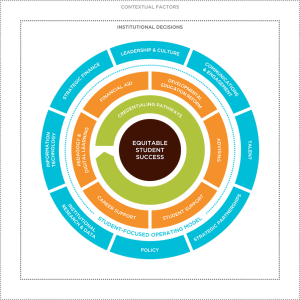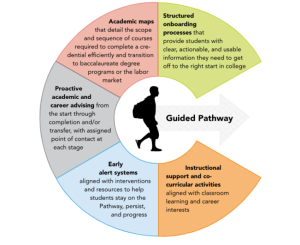
HOW INSTITUTIONS TRANSFORM
Continuous Improvement Process
What is Continuous Improvement?
Continuous improvement is a structured, data-informed process that helps identify problems, test solutions, and refine strategies over time. It’s cyclical by design—making space to reflect on what’s working, uncover gaps, and adapt for greater impact.
Rather than treating change as a one-time initiative, continuous improvement builds lasting momentum. It combats initiative fatigue, clarifies how transformation happens, and supports smarter, more sustainable decisions.
But this kind of change doesn’t happen only at the top. While leadership is essential, progress depends on the participation and leadership of people across the institution—faculty, mid-level managers, core staff, and frontline practitioners. When individuals are empowered to reflect, adapt, and improve, continuous improvement becomes part of the institutional culture.
How It Works
Institutions that use continuous improvement bring together cross-functional teams with the time, skills, and shared commitment to tackle a specific challenge. These teams rely on a mix of qualitative and quantitative data to:
- Understand a problem and the system that reinforces it.
- Set a clear, equity-focused aim, such as improving outcomes for students of color and low-income students.
- Develop a theory of change grounded in research and practice to identify the most promising interventions.
- Engage in inquiry cycles to test, refine, and scale. evidence-based solutions that address both the root causes and the system that produces it.
This process has been codified in the PRPAM framework—Prepare, Reflect, Prioritize, Act, and Monitor —which helps institutions embed strategy into routine practice, align efforts across teams, and build capacity for sustained transformation. It is especially effective in institutions with equity-centered goals, cross-functional structures and processes, and leadership that fosters collaboration, transparency, and shared ownership of progress. It is particularly valuable for solving challenges related to integrating initiatives, tracking impact, and leading systemic change across stakeholder groups.

Continuous Improvement Model (PRPAM)
These phases are connected—and continuous. Each cycle builds on the last, deepening impact and embedding equity-driven change over time.
Establish a shared vision. Define the challenge, build the team, and ground your work in equity and student success from the start.
Examine disaggregated data and student experiences to understand root causes. Identify what needs to change—and why it matters.
Focus your resources on what matters most. Target high-impact strategies that advance equity, improve student experience, and align with your mission.
Implement reforms through cross-functional coordination. Test strategies, support your teams, and adapt based on feedback and student outcomes.
Track results, gather insights, and assess progress. Use data and voice to refine strategy and ensure equity stays at the center.
An Integrated Approach to Transformation
While the path to transformation varies across institutions, certain processes consistently help colleges and universities take a more holistic, aligned approach to change.
Four key elements support this kind of integrated transformation:
- Strategic Planning
Used by leaders to orient their institutions toward student success. When grounded in cross-departmental collaboration, strategic planning sets the tone for coordinated, long-term transformation. - Transformation Frameworks
These frameworks help institutions understand and redesign the student journey. They serve as anchors for aligning reforms and embedding continuous improvement practices into day-to-day operations. - Cross-Functional Collaboration
Joint efforts across leadership, staff, and faculty build shared ownership and break down silos. These collaborations support distributed leadership and keep student success at the center of institutional work. - Reflection
Ongoing reflection is at the heart of continuous improvement. It allows teams to examine systems, identify barriers, and adapt practices based on learning and feedback.
Leaders who take a more integrated approach to student success often see stronger outcomes. Closely coordinated efforts allow institutions to align strategies, operations, and priorities with the realities of student experience. Embedding a cross-functional focus into planning processes often leads to the adoption of student experience frameworks, which in turn support reflection on how current practices shape student journeys.
Together, these four elements help institutions align strategy with execution and when intentionally integrated, they create the conditions needed for sustainable transformation.
Transformation Frameworks
Transformation frameworks help institutions integrate strategies, align efforts, and connect individual roles to broader student success goals. When used alongside strategic plans, they:
- Tie student journeys to institutional priorities.
- Break down silos and promote cross-functional collaboration.
- Offer a shared language and roadmap for faculty and staff.
- Provide structure for planning, implementation, and evaluation.
These frameworks are most powerful at the start of a transformation journey, helping institutions ensure their work is intentional, iterative, and equity-centered from day one. Below are several field-tested, research-based frameworks widely recognized for their effectiveness in guiding institutional transformation.
- Institutional Transformation Framework (ITF)
The ITF helps institutions realign their structures, culture, and business model to center equitable student success. Anchored in continuous improvement and aligned with the PRPAM cycle—Prepare, Reflect, Prioritize, Act, Monitor—the ITF guides the strategic integration of transformation concepts into everyday practice to support implementation and ongoing refinement.
At its core, the ITF centers the student experience, reflecting a deep institutional commitment to equity. To drive meaningful transformation, the ITF supports institutions to:- Define clear, sequenced pathways that lead students to credentials of value
- Identify and implement targeted, evidence-based supports to help students stay on those pathways
- Strengthen institutional capacities—such as leadership, finance, and data systems—that are essential to sustaining and scaling student-facing reforms.
By integrating strategy, implementation, and continuous refinement, the ITF enables institutions to align student-facing changes with long-term transformation goals.
- Preventing Loss, Creating Momentum Framework: The Loss-Momentum Framework (LMF)
The LMF helps institutions organize the student experience into four key phases:
- Connection
How students first engage with the institution - Entry
Navigating early academic decisions and supports - Progress
Advancing through coursework and staying on path - Completion/Transition
Reaching a credential and preparing for life beyond
- Connection
Institutions use the LMF to identify how systems, policies, and practices help or hinder students at each stage—and to drive redesign efforts accordingly.
- Pathways Framework
Pathways are comprehensive, evidence-based strategies designed to guide students from entry to completion. The framework focuses on four core areas:
- Clarify the Path
Help students explore and choose a program - Get on the Path
Support onboarding and first-year success - Stay on the Path
Provide advising, progress tracking, and early alerts - Ensure Learning
Strengthen teaching and integrate skill development
- Clarify the Path
Pathways frameworks connect academic, advising, and support structures to create a clear, coherent experience for all students—especially those historically underserved.
Cross-Functional Roles
Continuous improvement is sustained by people—not just processes. While senior leaders may set the vision, lasting progress depends on the capacity, commitment, and collaboration of individuals across the institution. When people are empowered to reflect, adapt, and act, continuous improvement becomes more than a routine—it becomes part of the institution’s culture.
Across roles, individuals play essential and evolving functions in this work:
- Senior Leaders—such as presidents, provosts, and chancellors—champion continuous improvement as a strategic priority. They align resources, model transparency, and remove barriers to progress. Their leadership reinforces equity-centered goals and builds the trust needed for iterative learning and long-term change.
- Mid-Level Leaders—including deans, department chairs, and directors—bridge strategy and implementation. They coordinate across departments, facilitate team reflection, and lead inquiry cycles that translate data and strategy into action. Their ability to align people and processes is critical to sustained progress.
- Faculty—from tenured professors to adjunct instructors—bring essential insight into how institutional policies, structures, and classroom practices shape learning. They contribute to redesigning curriculum, pedagogy, and assessment practices that support student success.
- Frontline Staff—such as academic advisors, financial aid counselors, and student support specialists—engage directly with students and surface day-to-day barriers in the system. Their close connection to the student experience makes them invaluable partners in identifying challenges and informing practical solutions.
- Core Staff—including institutional researchers, IT staff, and strategic planning leads—provide the infrastructure for improvement. They offer tools, training, and data that support reflective practice, facilitate collaboration, and sustain learning cycles across teams.
- Students are engaged as partners—not just participants. Their feedback, lived experience, and ideas help ensure that improvement efforts are grounded in what students need to navigate and thrive in the institution.
This people-centered approach ensures continuous improvement efforts are inclusive, actionable, and aligned with long-term transformation goals. When every role is engaged and supported, improvement becomes a shared habit—and institutions are better equipped to deliver equitable outcomes at scale.
Related Components of How Institutions Transform
HOW INSTITUTIONS TRANSFORM
Evidence-Based Practices
Student success starts with what students experience every day. This section introduces the student-facing reforms that make transformation visible—and shows how institutions focus their efforts where it matters most.
HOW INSTITUTIONS TRANSFORM
Core Institutional Capacities
Big changes require strong foundations. This section looks at the core capabilities—like leadership, finance, and data use—that help institutions organize, execute, and sustain transformation.




